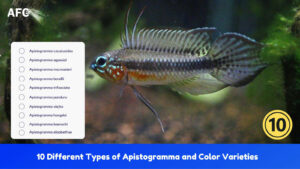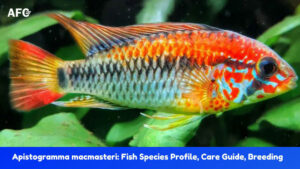Have you noticed any unusual behavior in the Betta fish whenever you make a little change to the water system?
Commonly known as Siamese fighting fish, Betta splendens are colorful and low maintenance. They are typically found in a mix of all rainbow colors like red, blue, and yellow but temporarily get discolored and form stripes when faced with stressful conditions.
If you are wondering, “what Betta stress stripes look like, we’ve got you covered with our informative guide.
What Are Betta Fish Stress Stripes?
Fishes often experience stress, just like humans do, but their trigger factors and the medium of expression are quite different. Now, Bettas indicate something being out of place in their surroundings through physical means.
Whenever there are adversities or sudden changes in the aquarium, this species starts discoloring and adopts a light or dark striped pattern. These stripes could be horizontal or vertical, depending on the reason behind their occurrence.
What Do Betta Stress Stripes Look Like?
When Bettas sense changes or get scared, they’ll lose their gorgeous colors and become pale. When this happens, they develop horizontally or vertically aligned parallel bands on their bodies that are quite different in color from their usual hues.
Female Betta: Breeding Or Fear Stripes
Both types of stripes might appear the same to untrained eyes, but if you pay attention, you’ll be able to notice a striking difference. Let’s look at how fear stripes differ from breeding stripes to learn how to demarcate them from each other.
Fear Stripes
Fish are capable of communicating through their body language; they change their appearance by altering their pigmentation and colors.
For instance, fear stripes are light horizontal streaks running along the female Betta’s body. These are caused when severe changes occur rapidly; you might have observed these stripes while siphoning the aquarium or netting your fish.
Breeding Stripes
While stress stripes are an indicator of tense situations, breeding stripes are a sign of good health in female Bettas. Yes, only females develop these stripes to indicate their prosperous breeding condition and invite males for mating.
Breeding stripes are vertically aligned light-colored bands, occurring in a series of five to six stripes. But these are less vibrant than the fear stripes.
Do Male Bettas Get Stress Stripes?
Stress stripes are common in female Bettas but not so apparent in males. The latter loses its color under stress and shows other behavioral changes. However, some pet owners on fish forums have mentioned their male Bettas developing stress stripes under immense stress or habitat change.
So, we can say that both males and females get stress stripes, but the phenomenon is much more pronounced in females than males.
How To Get Rid Of Betta Stress Stripes?
What Causes Stress Stripes?
Your Betta can get stressed for multiple reasons, so let us discuss the possible causes. This will help you find effective methods to look after your fish and get rid of the stress stripes.
Is it a New Tank?
Stress stripes commonly occur when Bettas are moved from the pet store to their new home. This species is sensitive to changes and adjusts to a new habitat in their own sweet time. The stripes will likely go away in a week, provided you keep the tank filtered, cycled, and properly heated.
Water Conditions
Fluctuations in the water quality can stress out your fish really fast. That’s why you should avoid introducing sudden changes in your water tank. If you want to improve the quality of the water, do it gradually, so Bettas have enough time to adapt without freaking out.
Apart from water, the general tank conditions also affect the stress level of this species. Bright lighting, fast water cycling, and a lack of hiding spots are a few factors that can cause stress stripes.
Make sure that your tank is large enough to accommodate all your fish comfortably (five gallons or more). Keep the lights dim and provide sufficient natural crevices to make your Bettas feel safe and secure.
Tankmates
Betta splendens is a solitary species that doesn’t react too well when kept with other fish. They might cohabitate with some assorted tropical fish without showing aggression, but that doesn’t necessarily mean they are compatible with them.
Bettas might become skittish and form stress stripes due to the presence of vividly colored and active fish around them. Therefore, it is important to observe their behavior closely while introducing new tankmates. If the stripes persist, it’s your sign to make some changes.
Getting Rid Of The Stripes
The best way to relieve Bettas from their stress stripes is by eliminating the source of stressful conditions. Make sure that you run water quality tests in your aquarium from time to time. What’s more, observe your Bettas’ movement and assess the space they are getting to move about and hide.
Notice your fish’s activity and movement in the water tank; is it swimming and moving around actively, or is it sulking at the bottom, most of the time? If the latter is the case, try adding more enrichments to the water.
Additionally, research the species you introduce inside your tank along with the Betta splendens. You need to make sure that your fish are reacting well to each other instead of being aggressive.
Final Thoughts
Bettas are known as “fighting fish,” but in reality, they are complex and sensitive, prone to getting stressed at the slightest inconvenience.
They are low maintenance but prefer solitary living and stress stripes are a sure sign that something is up and your fish is having a tough time. Moreover, prolonged stress can have a terrible effect on their immunity, making them vulnerable to diseases.
But the stress stripes will warn you beforehand; you’ll have ample time to figure things out and make them better for your Betta’s comfort.
We’ll sign off now, hoping that our guide was able to cater to all your queries. Don’t forget to let us know your thoughts in the comments below!





